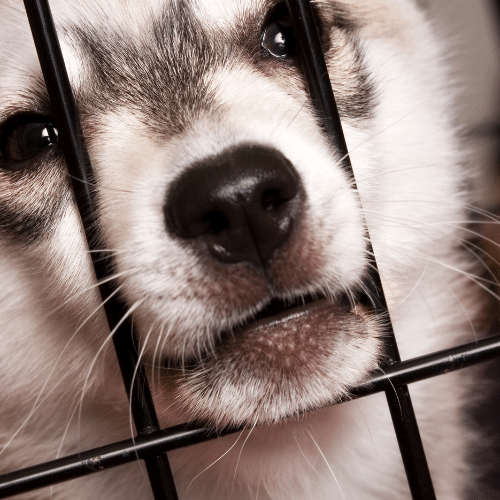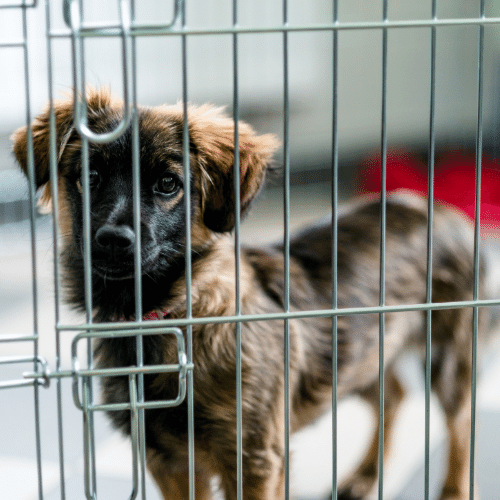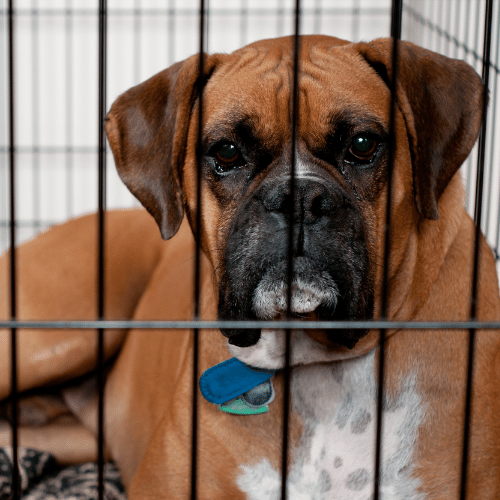Where Should I Put My Dog’s Crate at Night?
September 1, 2021 2021-09-01 11:55What about your dog’s crate at night? Crating your dog can be a peaceful experience for both you and your dog if it’s done correctly. Many people use a crate to help with a dog’s anxiety, restlessness, behavior issues, and housebreaking. If you recently added a new puppy to your home or are thinking about doing so, you might be wondering where to place your dog’s crate at night. Where will he feel most comfortable and safe? What will be the most convenient location?
Dogs, especially puppies, should feel that their crate is a safe place to be. If a new puppy is put in the crate alone after spending his entire life to that point with his mother and littermates, he might feel scared and abandoned. Let’s look at different places to put the crate and the reasons behind them.
Table of Contents

Should my dog’s crate be near me overnight?
Ideally, yes. If you can put the crate in your bedroom, it will help a new puppy settle down faster. If he can hear and see you, and continue to hear you breathing overnight, he will be much calmer than if his dog’s crate at night was in a room alone. This also helps you hear him overnight. If he stirs and whines, you can hear that he’ll need to be taken outside of the crate for a potty break. Remember that young puppies can’t hold their bladders longer than one hour for each month of their lives, as a general rule. So, if your puppy is four months old, he can’t hold it longer than four hours.
A puppy can really be scared in their dog’s crate at night for the first couple of weeks. They’re in a completely new situation and don’t know what’s happening or where they are. If you don’t feel comfortable putting the crate in your bedroom, put it in a room close by where you can talk to the puppy and he can know you’re still there. Leave a radio or TV on for him so he’s not sitting in silence. A white noise machine will also work to give your puppy a sense of security and calm him down.
What can I do to comfort him in his dog’s crate at night?
It’s natural that your puppy be scared and uncertain when he first goes into his dog’s crate at night. To help him keep calm, you can add some things to the crate. Things that are easily washable are best, like machine-washable bedding in case there’s a potty accident. Durable chew toys are good. You can also fill a large water bottle with warm water so the puppy can feel like he’s cuddling in the warmth of his siblings. If you have a chewing puppy, avoid anything soft until he’s proven he won’t chew his bedding. You might just want to line the crate bottom with puppy pads until he’s a bit older.
If your puppy whines to come out when you know he doesn’t have to go potty, give him some time to settle. Opening the crate door and taking him out to play or snuggle will show him that he can continue to cry in the crate just because he doesn’t want to be in it and will eventually get to come out. If the crate is in your bedroom, you can comfort him by speaking in a soothing tone, putting your hand down by the crate so he knows you’re there, and letting him hear you breathing. If he doesn’t feel like he’s alone, he should settle down and feel just in his dog’s crate at night. He’ll then learn what nighttime is and that his crate is for sleeping.

Areas to avoid when choosing a crate location
When selecting the location for your dog crate that isn’t in your bedroom, inspect the areas for any potential dangers first. Puppies – and dogs – will try to reach through the crate bars for anything they can grab to chew on or destroy. Keep all plants, especially poisonous ones, out of the area.
Anywhere people walk, such as high-traffic hallways and walkways, should also be avoided. Putting a dog crate in an area where people are always walking by will make your dog think that any minute now, one of these people is going to let him out. It will actually cause more anxiety in your dog than less and he could have a much harder time settling down.
Just as your dog shouldn’t be in a high-traffic area, he also shouldn’t be completely isolated from the family. Avoid spots that are too quiet and make your dog feel he’s alone.
Power cords are also dangerous. If your dog can reach the cords through the crate to chew on them, he could seriously injure himself. If cords are in the place you want to put the crate, remove the cords first. Plugged in or not, your dog doesn’t need to find a new hobby chewing these cords. Especially while in his dog’s crate at night.
Direct sunlight, direct air conditioning, and direct heat should be avoided. When you decide on a place for the crate, consider the windows. Will they let direct sunlight into the room and into the crate? Puppies and dogs should not be near a heater, fireplace, or air conditioner, as they have no way to move out of the air path. Always make sure the temperature in the crate is comfortable.
Don’t put the dog crate outside. Even if the temperature is pleasant and your dog enjoys being outdoors, it’s extremely dangerous to leave your dog crated outside by himself. Predators can come and terrify and possibly harm him through the crate bars. If he somehow manages to escape the crate, he can get lost. Someone can open the crate and steal him. Even in a locked and secure backyard, it’s never safe to leave your dog outside alone in a crate.
Covering the dog’s crate at night
Some dogs prefer their crate to be covered. It helps them settle faster, provides them a feeling of safety, and it limits the number of distractions they can see so they have an easier time falling asleep. Some dogs may not like the crate covered at all and get more upset if it is. If you choose to try covering the crate, make sure you don’t use something your dog can pull into his dog’s crate at night through the bars and chew. Crate covers can be purchased for the crate you have or you can choose to put the crate in a corner with a flat piece of wood over the top. That way, two sides are already covered, the top is covered, and your dog can still see out on two sides. Don’t cover the crate completely so your dog can’t see out at all. That could scare him more than calm him.
Should food and water be left in the crate?
Typically, no. A healthy dog should not need food or water in the crate overnight. This is a time for sleeping, and your dog won’t dehydrate during a night of sleep. Food and water in the crate can also lead to messes. Water gets spilled, soaking everything inside, including the dog. Food can get scattered or smeared everywhere. Having a mess to clean up inside the crate every day is not something you or your dog will appreciate.
Limiting their access to food and water overnight also means their potty schedule will stay on track. As long as your puppy or dog has enough food and water during the day, they should be able to go all night without needing more.

During the day
When you are home with your dog, it’s important to give him the attention and stimulation he needs to be happy and healthy. When you let him out of the crate in the morning, he will want to be around you. This is a good time for walks, playtime, training, and cuddling. Remember that when your dog is crated, all he has is the inside of the crate, waiting for you to return to let him out. Even though he may enjoy his crate, he doesn’t want to live his life inside of it. His ideal way to spend his day is with you doing fun things.
Dogs who don’t want to go inside the crate or don’t settle down easily after being crate-trained may not have had their needs met during the day. Make sure you give your dog adequate exercise, playtime, and mental stimulation when he’s awake. The last thing a bored dog will want to do is spend more time by himself in a crate when he hasn’t had a fulfilling day. Interactive toys can also help. A peanut butter or plain yogurt-filled Kong is a great crate treat that will keep him busy and give him something to look forward to when he goes inside. Puzzle toys that he has to solve in order to get rewarded with a treat are also good for keeping him stimulated and giving him something to do. The best thing you can do though to help your dog relax in his crate overnight is give him a fulfilling day. Of course, jobs and other responsibilities make it impossible to spend every waking moment with him, but try to schedule at least an hour of interactive play and exercise with your pup each day. He’ll be happier and sleep easier, and so will you.
The bottom line
At night, your dog’s crate should ideally be in your bedroom with you. Especially if you have a puppy, this location makes it easy to know if your dog needs you for anything, like a potty break. If you can’t put the crate in your bedroom, put it outside your room or in a room close by where you can still hear your dog and talk to him if need be.
You can comfort your dog if he cries, but avoid taking him out of the crate unless it’s absolutely necessary. Your dog should learn that his crate overnight is for sleeping.
When choosing a location for your dog’s crate that’s not your bedroom, some areas to avoid include high-traffic walkways and hallways, areas that are too far away from where the family hangs out, and places that include power cords or plants. Dogs will try to reach through the crate bars for anything they can pull in and chew.
Covering your dog’s crate may make him feel more secure, but it’s important to use a cover he can’t pull in through the bars and destroy.
Food and water aren’t necessary to leave in the crate overnight. Allow your dog to drink his fill of water before his last potty break before bed.
Giving your dog a fun and active day will help him have a relaxing night. Your dog looks to you to alleviate his boredom and he enjoys being around you.
Interactive toys and treats can help your dog settle down in his crate and focus on something to do. If he knows he’s being rewarded with these things inside, going into his crate will be something he looks forward to doing.

Author: Jessica Rossetti
Jessica lives in Chicago with her husband, Dominic, and their rescued cat, Toast. She has lived with dogs for over 30 years and spends her days writing, caring for various animals, and enjoying her backyard that has become an oasis for wild creatures.
Her passion for animals began at a young age when she would bring home the lost dog or cat. As she got older, she went on to bring home an injured bird or raccoon. This love and desire to help all creatures led to her work as an adult with various animal rescues, where she saved the lives of many domestic and wild animals while learning the necessary skills to care for them.
Owning and operating a professional pet care service in Chicago for the past twelve years, Jessica cares for dogs in her home while writing full-time.

